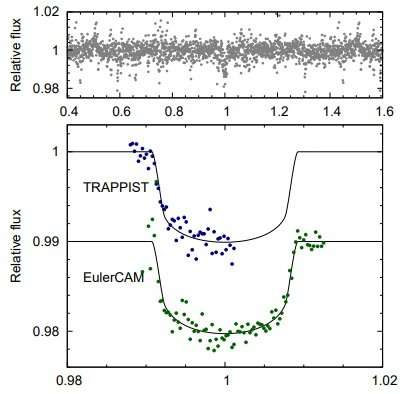WASP-162b discovery data. Credit: Hellier et al., 2018.
European astronomers have detected eight new "hot Jupiter" exoplanets as part of the WASP-South transit survey. The newly discovered gas giants have short orbital periods and masses ranging from 0.42 to 5.2 Jupiter masses. The finding is detailed in a paper published March 6 on arXiv.org.
The discovery was made by a team of researchers led by Coel Hellier of the Keele University, U.K. They used the WASP-South telescope at the South African Astronomical Observatory (SAAO) in South Africa. This telescope and SuperWASP-North in the Canary Islands, Spain, belong to an international consortium called WASP (Wide Angle Search for Planets) which is conducting an ultra-wide angle search for exoplanets using the transit photometry method.
Hellier's team identified transit signals in the light curves of eight different extrasolar worlds. The planetary nature of these signals was confirmed by follow-up observations at the Euler-Swiss telescope and the TRAnsiting Planets and PlanetesImals Small Telescope (TRAPPIST), both located in Chile.
"Here, we report the latest hot-Jupiter discoveries from the WASP-South transit survey, verified with the Euler/CORALIE spectrograph and with follow-up photometry from EulerCAM and from the robotic TRAPPIST photometer," the researchers wrote in the paper.
All the newly identified alien worlds were classified as "hot Jupiters," as they are similar in characteristics to the solar system's biggest planet, with orbital periods of less than 10 days. Such exoplanets have high surface temperatures, as they orbit their parent stars very closely.
With a mass of about 5.2 Jupiter masses, WASP-162b is the most massive planet out of the eight newly found "hot Jupiters." It is the size of Jupiter, and orbits its parent star every 9.62 days at a distance of about 0.09 AU from the host. Therefore, the astronomers calculated that this exoplanet has a temperature of 910 K. The star orbited by this planet is more than 1 billion years old, and is similar in size and mass to our sun.
WASP-168b is the least massive planet reported in the paper. However, although it has a mass of about 0.42 Jupiter masses, its radius is 50 percent larger than that of Jupiter's. Given that this exoplanet was found to be larger than it should be, the researchers describe it as a bloated "hot Jupiter." WASP-168b circles a star of spectral type F9V, which is about 10 percent larger and more massive than the Sun, every 4.15 days at a distance of 0.05 AU. The planet has a temperature of 1,340 K.
The authors of the paper emphasized that with regard to atmospheric characterisation, the most promising of the new planets is WASP-172b. It is a bloated, low-mass hot Jupiter (0.47 Jupiter masses; 1.57 Jupiter radii) orbiting a relatively bright star every 5.47 days, at about 0.07 AU from the host. The researchers noted that the atmosphere of this planet is predicted to be hot (about 1740 K) due to the hot, F1 host star.
The remaining five exoplanets, designated WASP-144b, WASP-145Ab, WASP-158b, WASP-159b and WASP-173Ab have masses ranging from 0.44 to 3.7 Jupiter masses and radii between 0.85 and 1.4 Jupiter radii. WASP-145Ab and WASP-173Ab are in double-star systems.
More information: New transiting hot Jupiters discovered by WASP-South, Euler/CORALIE and TRAPPIST-South, arXiv:1803.02224 [astro-ph.EP] arxiv.org/abs/1803.02224
Abstract
We report the discovery of eight hot-Jupiter exoplanets from the WASP-South transit survey. WASP-144b has a mass of 0.44 Mj, a radius of 0.85 Rj, and is in a 2.27-d orbit around a V = 12.9, K2 star which shows a 21-d rotational modulation. WASP-145Ab is a 0.89 Mj planet in a 1.77-d orbit with a grazing transit, which means that the planetary radius is not well constrained. The host is a V = 11.5, K2 star with a companion 5 arcsecs away and 1.4 mags fainter. WASP-158b is a relatively massive planet at 2.8 Mj with a radius of 1.1 Rj and a 3.66-d orbit. It transits a V = 12.1, F6 star. WASP-159b is a bloated hot Jupiter (1.4 Rj and 0.55 Mj) in a 3.8-d orbit around a V = 12.9, F9 star. WASP-162b is a massive planet in a relatively long and highly eccentric orbit (5.2 Mj, P = 9.6 d, e = 0.43). It transits a V = 12.2, K0 star. WASP-168b is a bloated hot Jupiter (0.42 Mj, 1.5 Rj) in a 4.15-d orbit with a grazing transit. The host is a V = 12.1, F9 star. WASP-172b is a bloated hot Jupiter (0.5 Mj; 1.6 Rj) in a 5.48-d orbit around a V = 11.0, F1 star. It is likely to be the best planet of those reported here for atmospheric characterisation. WASP-173Ab is a massive planet (3.7 Mj) with a 1.2 Rj radius in a circular orbit with a period of 1.39 d. The host is a V = 11.3, G3 star, being the brighter component of the double-star system WDS23366-3437, with a companion 6 arcsecs away and 0.8 mags fainter. One of the two stars shows a rotational modulation of 7.9 d.
© 2018 Phys.org
























